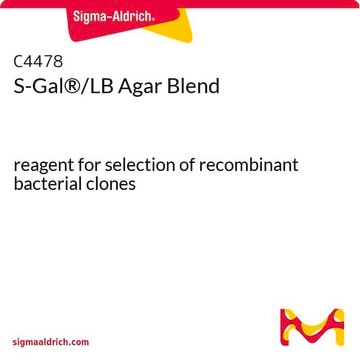16669
Magenta-Gal
reagent for selection of recombinant bacterial clones
Synonym(s):
5-Bromo-6-chloro-3-indolyl-β-D-galactopyranoside, Mag-Gal
About This Item
Recommended Products
grade
for molecular biology
Quality Level
sterility
non-sterile
Assay
≥98.0% (HPLC)
form
powder
solubility
DMF: soluble
DMSO: soluble
suitability
suitable for β-galactosidase test
storage temp.
−20°C
SMILES string
OC[C@H]1O[C@@H](Oc2c[nH]c3cc(Cl)c(Br)cc23)[C@H](O)[C@@H](O)[C@@H]1O
InChI
1S/C14H15BrClNO6/c15-6-1-5-8(2-7(6)16)17-3-9(5)22-14-13(21)12(20)11(19)10(4-18)23-14/h1-3,10-14,17-21H,4H2/t10-,11-,12+,13-,14-/m1/s1
InChI key
CHRVKCMQIZYLNM-RKQHYHRCSA-N
General description
Application
Principle
related product
Storage Class Code
13 - Non Combustible Solids
WGK
WGK 3
Flash Point(F)
Not applicable
Flash Point(C)
Not applicable
Personal Protective Equipment
Choose from one of the most recent versions:
Already Own This Product?
Find documentation for the products that you have recently purchased in the Document Library.
Our team of scientists has experience in all areas of research including Life Science, Material Science, Chemical Synthesis, Chromatography, Analytical and many others.
Contact Technical Service







